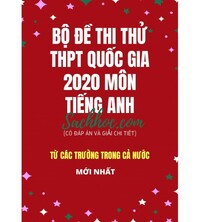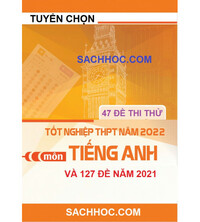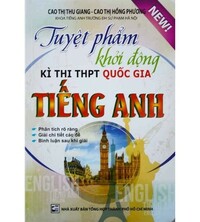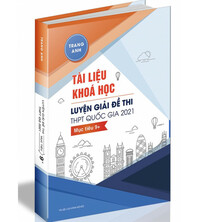Tài liệu Giản lược mệnh đề quan hệ Tiếng Anh dưới đây nằm trong bộ đề Ôn tập Ngữ pháp Tiếng Anh cơ bản mới nhất trên Tìm Đáp Án. Tài liệu Tiếng Anh gồm 6 cách Rút gọn mệnh đề quan hệ trong Tiếng Anh khác nhau như: Rút gọn mệnh đề bằng cụm Cụm V-ing, cụm V-ed, To inf, cụm danh từ, mệnh đề tính từ có dạng be và tính từ/ cụm tính từ, mệnh đề tính từ thành tính từ ghép, ... và bài tập Tiếng Anh rút gọn mệnh đề quan hệ có đáp án.
English Grammar: Reduced Relative Clause
- A. Lý thuyết rút gọn mệnh đề quan hệ
- I. Rút gọn mệnh đề quan hệ bằng cách dùng participle phrases (V-ing phrase)
- II. Rút gọn bằng cách dùng past participle phrase (V-ed phrase)
- III. Rút gọn mệnh đề quan hệ bằng to infinitive
- IV. Rút gọn mệnh đề quan hệ dùng cụm danh từ (đồng cách danh từ)
- V. Mệnh đề rút gọn tính từ có dạng be và tính từ/cụm tính từ
- VI. Mệnh đề tính từ thành tính từ ghép
- B. Bài tập Rút gọn mệnh đề quan hệ
A. Lý thuyết rút gọn mệnh đề quan hệ
Có 6 cách rút gọn câu dùng mệnh đề quan hệ trong tiếng Anh.
I. Rút gọn mệnh đề quan hệ bằng cách dùng participle phrases (V-ing phrase)
Nếu động từ trong mệnh đề quan hệ ở thể chủ động (active), ta dùng cụm hiện tại phân từ (present participle phrase) thay cho mệnh đề đó. Thao tác: Bỏ đại từ quan hệ và trợ động từ, đưa động từ chính về nguyên mẫu và thêm đuôi – ing.
Ex: The man who is standing there is my brother => The man standing there is my brother
Do you know the boy who broke the windows last night? => Do you know the boy breaking the windows last night?
II. Rút gọn bằng cách dùng past participle phrase (V-ed phrase)
Nếu động từ trong mệnh đề quan hệ ở thể bị động (passive) ta dùng cụm quá khứ phân từ (past participle phrase).
Ex: The books which were written by Nam Cao are interesting => The books written by Nam Cao are interesting.
The students who were punished by teacher are lazy =>The students punished by teacher are lazy.
III. Rút gọn mệnh đề quan hệ bằng to infinitive
Dùng khi danh từ đứng trước có các chữ sau đây bổ nghĩa: the only, the first, the second,… the last, so sánh nhất, mục đích.
Ex: Tom is the last person who enters the room = Tom is the last person to enter the room.
John is the youngest person who takes part in the race =>John is the youngest person to take part in the race.
Động từ là HAVE/ HAD
Ex: I have much homework that I must do => I have many homework to do.
Đầu câu có HERE (BE), THERE (BE)
Ex: There are six letters which have to be written today => There are six letters to be written today.
IV. Rút gọn mệnh đề quan hệ dùng cụm danh từ (đồng cách danh từ)
Dùng khi mệnh đề quan hệ tình từ có dạng: S + BE + DANH TỪ /CỤM DANH TỪ/CỤM GIỚI TỪ Cách làm: bỏ who ,which và be.
Ex: Football, which is a popular sport, is very good for health => Football, a popular sport, is very good for health.
Do you like the book which is on the table? => Do you like the book on the table?
V. Mệnh đề rút gọn tính từ có dạng be và tính từ/cụm tính từ
Có 2 công thức rút gọn:
Công thức 1: Bỏ who, which…to be -> giữ nguyên tính từ phía sau.
Điều kiện 1: Nếu phía trước that là đại từ phiếm chỉ như something, anything, anybody…
Ex: There must be something that is wrong => There must be something wrong.
Điều kiện 2: Có dấu phẩy phía trước và phải có từ 2 tính từ trở lên.
Ex: My grandmother, who is old and sick, never goes out of the house => My grandmother, old and sick, never goes out of the house.
Công thức 2: Những trường hợp còn lại ta đem tính từ lên trước danh từ.
Ex: My grandmother, who is sick, never goes out of the house => My sick grandmother never goes out of the house.
I buy a hat which is very beautiful and fashionable => I buy a very beautiful and fashionable hat.
Tuy nhiên nếu cụm tính từ gồm cả danh từ ở trong nó thì ta chỉ còn cách dùng V-ing mà thôi.
Ex: I met a man who was very good at both English and French => I met a man being very good at both English and French.
Tóm lại cách rút gọn loại này khá phức tạp vì nó tùy thuộc vào đến 3 yếu tố: có một hay nhiều tính từ – danh từ đứng trước có phải là phiếm chỉ không có dấu phẩy hay không
VI. Mệnh đề tính từ thành tính từ ghép
Cách làm: Ta sẽ rút gọn mệnh đề thành một tính từ ghép bằng cách tìm trong mệnh đề một số đếm và danh từ đi sau nó, sau đó ta để chúng kế nhau và thêm dấu gạch nối ở giữa. Đem tính từ ghép đó ra trước danh từ đứng truớc who, which…- những phần còn lại bỏ hết.
Lưu ý:
+ Danh từ không được thêm “s”
+ Chỉ dùng được dạng này khi mệnh để tính từ có số đếm
+ Các cụm như tuổi thì sẽ viết lại cả 3 từ và gạch nối giữa chúng (two years old à two-year-old)
Ex: I have a car which has four seats => I have a four-seat car. I had a holiday which lasted two days => I had a two-day holiday.
B. Bài tập Rút gọn mệnh đề quan hệ
Bài 1. REWRITE THE RELATIVE CLAUSES BY USING PHRASES
1. The man who’s talking to the policeman has just returned home from Paris.
2. The novel which was bought by my sister is very interesting.
3. The students who make noise in class will be punished.
4. Passengers who travelled on this bus bought their tickets in books.
5. Do you see the notice which warns people not to enter the military zone?
6. The stairs which lead to the cellar are rather slippery.
7. We had a river in which we could swim.
8. You are the last person who saw her alive.
9. The pilot was the only one who survived the air crash.
10. He was the second man who was killed in this way.
11. Neil Armstrong was the first man who walked on the moon.
12. Here are some accounts that you must check.
13. I’ve got a bottle of wine but I haven’t got anything that I could open it with.
14. I have some letters that I must write.
15. He simply loves parties. He is always the first who comes and the last who goes.
16. The Queen Elizabeth is the largest ship which has been built on the Clyde.
17. My grandmother, who is old and sick, never goes out of the house.
18. Kuala Lumpur, which is the capital city of Malaysia, is a major trade center in Southeast Asia.
19. Emma Thompson is the most famous actress who will appear on stage here.
20. We have some picture books that children can read.
21. I come from a city that is located in the southern part of the country.
Đáp án
1. The man talking to the policeman has just returned home from Paris.
2. The novel bought by my sister is very interesting.
3. The students making noise in class will be punished.
4. Passengers travelling on this bus bought their tickets in books.
5. Do you see the notice warning people not to enter the military zone?
6. The stairs leading to the cellar are rather slippery.
7. We had a river to swim.
8. You are the last person to see her alive.
9. The pilot was the only one to survive the air crash.
10. He was the second man to be killed in this way.
11. Neil Armstrong was the first man to walk on the moon.
12. Here are some accounts to check.
13. I’ve got a bottle of wine but I haven’t got anything to open it with.
14. I have some letters to write.
15. He simply loves parties. He is always the first to come and the last to go.
16. The Queen Elizabeth is the largest ship to be built on the Clyde.
17. My old and sick grandmother never goes out of the house.
18. Kuala Lumpur, the capital city of Malaysia, is a major trade center in Southeast Asia.
19. Emma Thompson is the most famous actress to appear on stage here.
20. We have some picture books to be read by children. .
21. I come from a city located in the southern part of the country.
Bài 2. Rút gọn mệnh đề quan hệ trong tiếng Anh
1.The man who is standing there is a clown.
2. The envelop which lies on the table has no stamp on it.
3. Benzene, which was discovered by Faraday, became the starting point in the manufacture of many dyes, perfumes and explosives.
4. My grandmother, who is old and sick, never goes out of the house.
5. The student don't know how to do exercise which were given by the teacher yesterday.
6. The diagrams which were made by young Faraday were sent to Sir Humphry Davy at the end of 1812.
7. The gentleman who lives next door to me is a well-known orator.
8. All the astronauts who are orbiting the earth in space capsules are weightless.
9. All students don't hand in their papers will fail in the exam.
10. I saw many houses that were destroyed by the storm.
11. The street which leads to the school is very wide.
12. The system which is used here is very successful.
13. John, who teaches my son, is my neighbor.
14. Trains which leave from this station take an hour to get to London.
15. The candidates who are sitting for the exam are all from Vietnam.
16. We are driving on the road which was built in 1980.
17. Customers who complain about the service should see the manager.
18. The city which was destroyed during the war has now been rebuilt.
19. My brother, who met you yesterday, works for a big firm.
20. The vegetable which are sold in this shop are grown without chemicals.
Đáp án
1.The man standing there is a clown.
2. The envelop lies on the table has no stamp on it.
3. Benzene, discovered by Faraday, became the starting point in the manufacture of many dyes, perfumes and explosives.
4. My grandmother, being old and sick, never goes out of the house.
5. The student don't know how to do exercise given by the teacher yesterday.
6. The diagrams made by young Faraday were sent to Sir Humphry Davy at the end of 1812.
7. The gentleman living next door to me is a well-known orator.
8. All the astronauts orbiting the earth in space capsules are weightless.
9. All students not handing in their papers will fail in the exam.
10. I saw many houses destroyed by the storm.
11. The street leading to the school is very wide.
12. The system used here is very successful.
13. John, teaching my son, is my neighbor.
14. Trains leaving from this station take an hour to get to London.
15. The candidates sitting for the exam are all from Vietnam.
16. We are driving on the road built in 1980.
17. Customers complaining about the service should see the manager.
18. The city destroyed during the war has now been rebuilt.
19. My brother, meeting you yesterday, works for a big firm.
20. The vegetable sold in this shop are grown without chemicals.
Trên đây là toàn bộ nội dung của tài liệu Ngữ pháp Tiếng Anh: Rút gọn mệnh đề quan hệ. Mời bạn đọc tham khảo thêm nhiều tài liệu ôn tập Tiếng Anh cơ bản khác như: Tài liệu luyện kỹ năng Tiếng Anh cơ bản, Ôn tập Ngữ pháp Tiếng Anh, Luyện thi Tiếng Anh trực tuyến,... được cập nhật liên tục trên Tìm Đáp Án.







